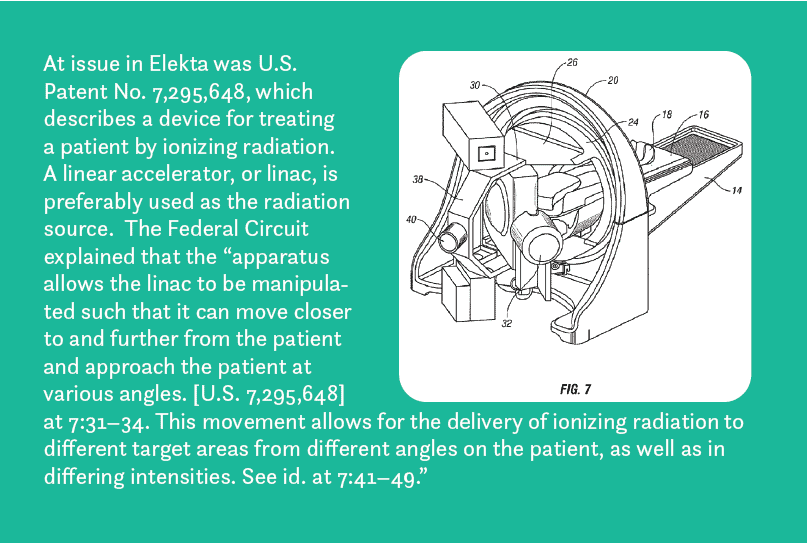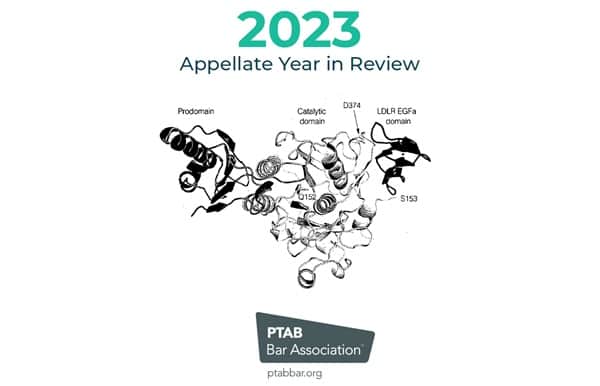By Scott B. Amankwatia
“Decoding Motivation to Combine Principles in Key Rulings” as published in the 2023 APELLATE YEAR IN REVIEW from the PTAB Bar Association (Download the PDF here)
In 2023, the Federal Circuit issued several opinions addressing motivation to combine in the context of inter partes review. As we will see in Axonics v. Medtronic (No. 22-1451), Elekta Limited v. Zap Surgical Systems (No. 21-1985), Intel Corporation v. Pact XPP Schweiz AG (No. 22-1038), Medtronic v. Teleflex Innovations S.A.R.L. (No. 21-2359), and Schwendimann v. Neenah (No. 22-1333), the court provides guidance as to what Practitioners should take into consideration when conducting a motivation to combine analysis.
AXONICS V. MEDTRONIC¹
The Board found that Axonics had not demonstrated a motivation to combine a medical/neurostimulation lead (Young reference) with a plurality of electrodes (Gerber reference) such that the plurality of electrodes are distal to portions of the leads. The court found that the Board narrowly focused on whether a motivation would exist to make the Young-Gerber combination for application of a neurostimulation technology specifically to a trigeminal nerve.
Application to the trigeminal nerve was not part of the Medtronic patents’ claims because Medtronic patents’ claims were directed to the sacral nerve. Thus, the court held that the Board made legal error by confining the motivation to combine analysis to the trigeminal nerve because only the sacral nerve was covered by the claims at issue.
ELEKTA V. ZAP SURGICAL²
The Board found that a POSITA would have been motivated to combine a known medical imaging device (Grady reference) with a known radiation treatment device (Ruchala reference). The court affirmed the Board by determining the motivation to combine was supported by substantial evidence, and that substantial evidence included: the patent’s prosecution history, teachings of the references, and expert testimonies. Elekta contended that the Board erred in not explicitly articulating findings on reasonable expectation of success. The court held that such a finding can be implicit. The court emphasized that obviousness determinations require a finding that a POSITA would have a reasonable expectation of success in combining references. The court noted that the Board had implicitly addressed this by considering intertwined arguments, including the motivation to combine. The court determined that the Board reasonably inferred a POSITA would have reasonable expectation of success based on the advantages of the device of Grady and despite the challenges in accommodating the Ruchala radiation device (which was heavy and required precise positioning).
At issue in Elekta was U.S. Patent No. 7,295,648, which describes a device for treating a patient by ionizing radiation. A linear accelerator, or linac, is preferably used as the radiation source. The Federal Circuit explained that the “apparatus allows the linac to be manipulated such that it can move closer to and further from the patient and approach the patient at various angles. [U.S. 7,295,648] at 7:31–34. This movement allows for the delivery of ionizing radiation to different target areas from different angles on the patient, as well as in differing intensities. See id. at 7:41–49.”

INTEL V. PACT XPP³
The Board determined that Intel did not sufficiently explain how a POSITA would modify the King reference to incorporate a shared communication bus from the Arimilli reference. Intel argued that the Board erroneously required Intel to prove that Arimilli’s caching mechanism, including its specific bus structure, could be physically or “bodily incorporated” into King’s communication bus system. PACT’s expert’s declaration asserted that combining the systems of King and Arimilli would increase latency and reduce the speed of the system.
The court indicated that latency/ speed cost alone cannot render a motivation to combine obsolete. Rather, the motivation analysis requires a determination as to “whether the benefits of the implementation outweigh the cost.” As a result, the court found compelling evidence that a POSITA would have been motivated to combine Arimilli and King because the references, like the challenged patent, focused on improving the processing speed of multiprocessor systems.
MEDTRONIC V. TELEFLEX⁴
The Board found that a POSITA would not have been motivated to combine a medical device (evacuation sheath to reduce blockage in blood vessels) of Ressemann with the medical device (support catheter) of Kontos. Medtronic argued that the Board legally erred by focusing on the detrimental effects of the proposed modification to one of Ressemann’s intended purposes because, as a result, the Board neglected Ressemann’s other purpose of delivering interventional cardiological devices. According to Medtronic, the Board’s reasoning conflicts with the court’s decision in Intel Corp. v. Qualcomm Inc. In Intel, the Court held that the “intended purpose of [a reference] does not control.”
The court affirmed the Board by clarifying the Intel holding: a proposed modification’s destruction of a device’s primary purpose is not legally irrelevant to an obviousness determination. The court had held in Polaris v. Artic Cat⁵ that legal error occurs if the Board ignores evidence that a proposed modification would interfere with a reference’s stated purpose. In this case, the court asserted that that the destruction of Ressemann’s entire purpose (removing sealing balloons, which help reduce blockage) is probative because that is a shared purpose with the challenged claims. Thus, destruction of a primary purpose can be probative if that purpose is shared with the challenged claims.
SCHWENDIMANN V. NEENAH⁶
The Board had found that the combination of the Kronzer and Oez references teach or suggest all the limitations recited in the challenged claims. The Board concluded that both Kronzer and Oez were directed towards improving the image transfer quality of multi-layered transfer sheets. The Board agreed with Neenah’s argument that express teachings from both references supported that a POSITA would be motivated to combine Kronzer and Oez. On appeal, Ms. Schwendimann argued that Neenah and the Board were required to explain why a POSITA would have chosen Kronzer (and not Oez) as the primary reference for the proposed combination. The court affirmed the Board.
The court found that the phrase “Kronzer in view of Oez” means that Kroner is the primary reference. The court asserted that “where the relevant factual inquiries underlying an obviousness determination are otherwise clear,” characterizing references “as ‘primary’ and ‘secondary’ is merely a matter of presentation with no legal significance.”
CONCLUSION
These rulings can be decoded as to emphasizing a holistic approach for a motivation to combine analysis. The technical feasibility and broader context and intent behind the references is important for the motivation to combine analysis. Practitioners should be cognizant that a motivation to combine analysis is not a mere check-box exercise, but a nuanced evaluation of how different pieces of prior art can logically and feasibly be combined in light of the requirements and purpose of the claimed invention.
1 Axonics, Inc. v. Medtronics, Inc., 73 F.4th 950 (Fed. Cir. 2023).
2 Elekta Limited v. Zap Surgical Systems, Inc., 81 F.4th 1368 (Fed. Cir. 2023).
3 Intel Corp. v. PACT XPP Schweiz AG, 61 F.4th 1373 (Fed. Cir. 2023).
4 Medtronic, Inc. v. Teleflex Innovations S.A.R.L., 69 F.4th 1341 (Fed. Cir. 2023).
5 Polaris Indus. V. Arctic Cat, Inc., 882 F.3d 1056, 1061, 1067-69 (Fed. Cir. 2018).
6 Jodi A. Schwendimann v. Neenah, Inc., 82 F.4th 1371 (Fed. Cir. 2023).

